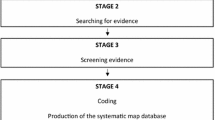Abstract
This paper extends the co-word method for mapping science, adopting new statistical and graphical methods to explore time-series data and the changing distribution of effort between different research themes. It also tests the reliability of the co-word method, comparing coword data on the acidification of the environment with data derived from a large scale interview study. Overall, the study increases our confidence in the reliability of the co-word method. In particular, it leads us to the following conclusions: (a) that the PASCAL database is representative, at least in the area of acidification research; (b) that indexer bias is negligible; and (c) that the co-word method satisfactorily identifies groups of research themes and the way in which these evolve.
Similar content being viewed by others
Notes and References
On the latter, seeW.L. Giusti, L. Georghiou, The use of co-nomination analysis in real-time evaluation of R & D programme,Scientometrics, 14 (1988) 265–281; and for general background on bibliometrics seeF. Narin,Evaluative Bibliometrics: the Use of Publication and Citation Analysis in the Evaluation of Scientific Activity, Contract NSF C-627, National Science Foundation, 31 March, 1976, Monograph: 466.
For details see the early chapters inM. Callon, J. Law, A. Rip (Eds),Mapping the Dynamics of Science and Technology: Sociology of Science in the Real World, London, Macmillan, 1986; see alsoM. Callon, J. Law, On the construction of sociotechnical networks: Content and context revisited,Knowledge and Society, 9 (1989) 57–83; andB. Latour,Science in Action: How to Follow Scientists and Engineers Through Society, Milton Keynes, Open University Press, 1987.
See Chapters two, three and four inCallon, Law, Rip, ibid.
SeeP. Healey, H. Rothman, P.K. Hoch, An experiment in science mapping for research planning,Research Policy, 15 (1986) 233–251.
Ibid..
One of the authors makes a related point. SeeJ. Whittaker, Creativity and conformity in science: Titles, keywords, and co-word analysis,Social Studies of Science, 19 (1989) 473–496. He compares coword analyses of titles and keywords, and finds that though these are comparable, the former produce fewer connections than the latter — perhaps because titles are intended to demonstrate the originality of a piece of research, whereas the keywords are intended to index (the equally real) connections between different publications. He also considers the different methodological assumptions underlying cluster analysis (which assumes thatall keywords, titles or articles should be assigned to a cluster) and co-word analysis (which makes no such assumption).
S. Bauin, Aquaculture: a field by bureaucratic fiat, pages 124–141 in:Callon, Law and Rip,op. cit, note 2.M. Callon, J. Law, A. Rip (Eds),Mapping the Dynamics of Science and Technology: Sociology of Science in the Real World, London, Macmillan, 1986;Mapping the Dynamics of Science and Technology: Sociology of Science in the Real World, London, Macmillan, 1986;
For certain more recent developments coming from the Paris group seeM. Callon, J.-P. Courtial, W. Turner, La methode leximappe: un outil pour l'analyse strategique du development scientifique et technique, pages 208–277 in:D. Vinck (Ed.),Gestion de la Recherche, Brussels, De Boeck, 1991.
This is the burden of writing by such authors asT. Kuhn,The Structure of Scientific Revolutions, Chicago, Chicago University Press, 1970;B. Latour, S. Woolgar,Laboratory Life: The Social Construction of Scientific Facts, Beverly Hills and London, Sage, 1979; andS. Shapin, S. Schaffer,Leviathan and the Air Pump: Hobbes, Boyle and the Experimental Life, Princeton and Oxford, Princeton University Press, 1985; for recent edited collections seeG. Fyfe, J. Law (Eds),Picturing Power: Visual Depiction and Social Relations, Routledge, London, 1988; andM. Lynch, S. Woolgar (Eds),Representation in Scientific Practice, Cambridge, Mass. and London, MIT Press, 1990.
Again there is a large literature on this. See, for instance,A. Cicourel,Method and Measurement in Sociology, New York, Free Press, 1964, who questions the assumptions and uses of social statistics. And in scientometrics, seeJ. Whittaker,op. cit., note 16.J. Whittaker, Creativity and conformity in science: Titles, keywords, and co-word analysis,Social Studies of Science, 19 (1989) 473–496. Creativity and conformity in science: Titles, keywords, and co-word analysis,Social Studies of Science, 19 (1989) 473–496.
Author information
Authors and Affiliations
Additional information
It is with deep sadness and regret thatJohn Law has to report the tragic and unexpected death ofJohn Whittaker. The present paper was partially drafted before his death and reports findings that were the result of a close three-year collaboration. The final draft is, however, the responsibility ofJohn Law alone.
Rights and permissions
About this article
Cite this article
Law, J., Whittaker, J. Mapping acidification research: A test of the co-word method. Scientometrics 23, 417–461 (1992). https://doi.org/10.1007/BF02029807
Received:
Issue Date:
DOI: https://doi.org/10.1007/BF02029807




